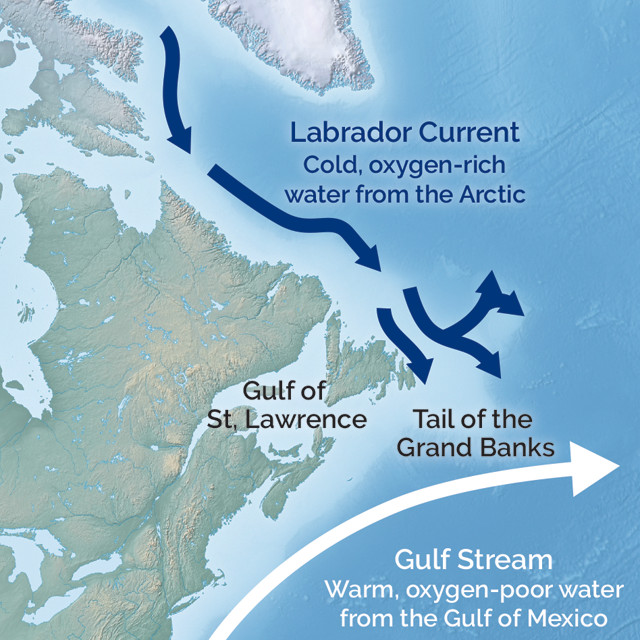
by Mary Caperton Morton Friday, December 21, 2018

Research suggests that the Gulf Stream is shifting to the north, such that it's impinging on the flow of the Labrador Current near the Tail of the Grand Banks and reducing the supply of well-oxygenated water to the Gulf of St. Lawrence. Credit: K. Cantner, AGI.
Estuaries are among the most nutrient-rich and biologically productive areas of the ocean, and the Gulf of St. Lawrence, where freshwater from the Great Lakes and the St. Lawrence River meets the salty Atlantic Ocean in eastern Canada, is the largest estuary in the world. But the biodiversity and long-thriving fisheries of the Gulf of St. Lawrence could be threatened by declines in oxygen levels over the last half century. A new study suggests that a large-scale shift in Atlantic Ocean circulation is dumping warmer, oxygen-poor water into the gulf.
To protect the gulf, Canada’s Department of Fisheries and Oceans (DFO) has been monitoring its health since the 1930s. “It’s quite rare in oceanography to have such long records,” says Mariona Claret, an oceanographer at the University of Washington, who led a new study of the gulf, published in Nature Climate Change. “We combined these records with centennial-scale time series of temperature and salinity collected at the Tail [southern extremity] of the Grand Banks of Newfoundland, where the Labrador Current and the Gulf Stream meet, which is one of the best-sampled areas in the entire ocean.”
In 2005, a study published in the journal Limnology and Oceanography and led by DFO’s Denis Gilbert, also a co-author of the new study, found a 72-year record of declining oxygen levels in the Gulf of St. Lawrence. “This deoxygenation trend was very alarming, but we didn’t know what was driving it,” Claret says. “Was it due to a local change in the gulf itself or a more remote change in the open ocean?”
In the new study, Claret, who was at McGill University in Montreal at the time of the work, and her colleagues combined the long-term datasets with a high-resolution Geophysical Fluid Dynamics Laboratory (GFDL) climate model developed by NOAA. This climate model simulates large-scale global ocean circulation as well as the coastal circulation that influences the Gulf of St. Lawrence. The researchers found that the gulf’s declining oxygen is due in part to a northward shift of the Gulf Stream over the last century.
The Gulf Stream originates in the Gulf of Mexico, bringing warm, oxygen-poor water from the south up the Eastern Seaboard to the North Atlantic. Meanwhile the Labrador Current flows down from the Arctic Ocean, delivering cold, oxygen-rich water to the Gulf of St. Lawrence. The GFDL climate model showed that warming has triggered a shift in ocean dynamics such that the Gulf Stream is impinging on the Tail of the Grand Banks, reducing the supply of well-oxygenated Labrador Current waters to the Gulf of St. Lawrence. Moreover, based on the model, the researchers traced this shift in large-scale currents to the slowdown of the Atlantic Meridional Overturning Circulation, which is the Atlantic branch of the global thermohaline ocean circulation. Linking these global and local systems with the model is an important step forward, Claret says.
Since 1960, oxygen levels in the global ocean have dropped about 2 percent, while oxygen in the deeper parts of the interior of the Gulf of St. Lawrence have declined by as much as 50 percent. “This trend of declining oxygen in the world’s oceans has the potential to affect biodiversity, fisheries and the cycling of nutrients and other elements that are important to the way the oceans function,” says Denise Breitburg, a marine and estuary ecologist at the Smithsonian Environmental Research Center in Edgewater, Md., who was not involved in the new study. “As the American Lung Association’s catchphrase used to say, ‘If you can’t breathe, nothing else matters.’” Breitburg says she’d “like to see modeling approaches like the one used in this study applied in more places. That will help us piece together the changes we’re seeing, and can expect to see in the future, in the ocean as a whole.”
© 2008-2021. All rights reserved. Any copying, redistribution or retransmission of any of the contents of this service without the expressed written permission of the American Geosciences Institute is expressly prohibited. Click here for all copyright requests.